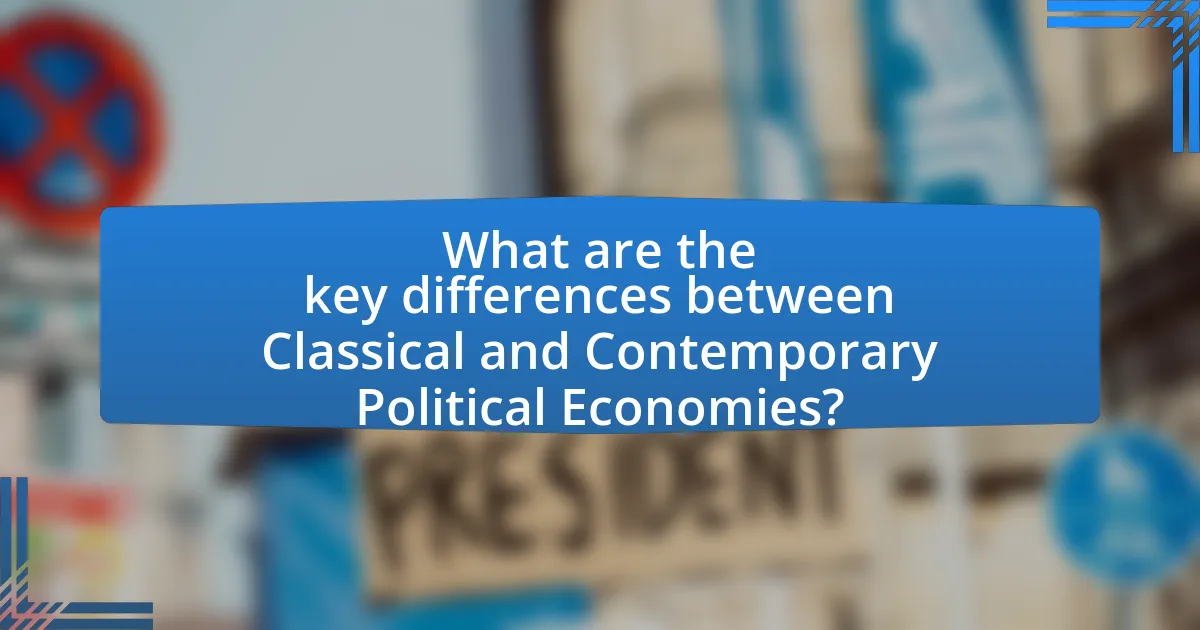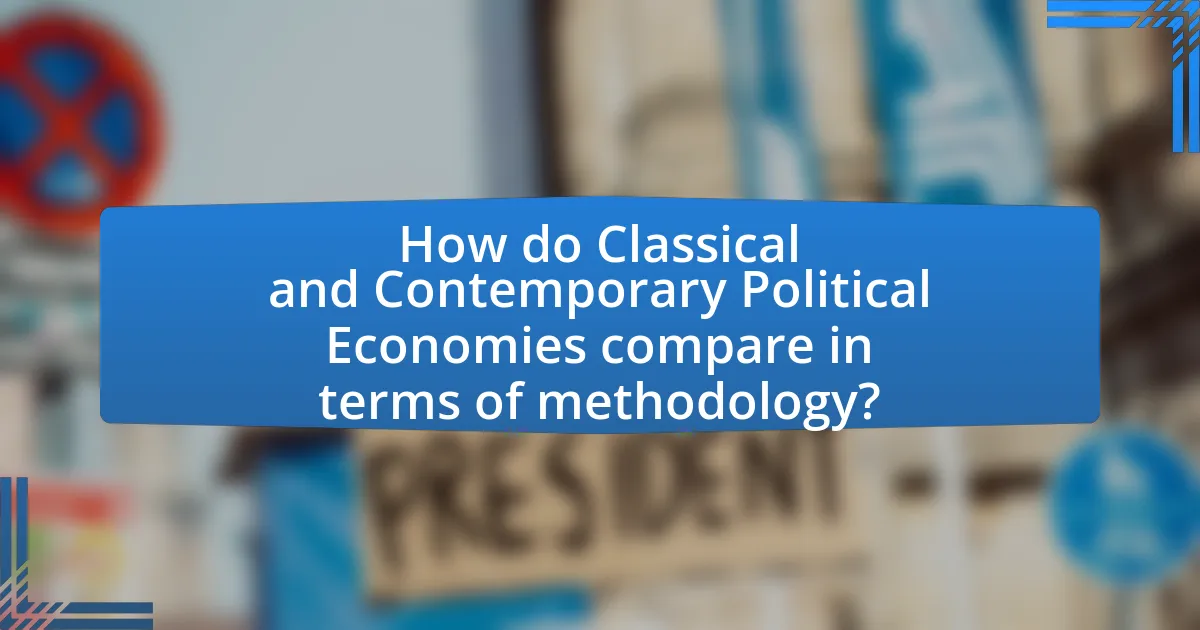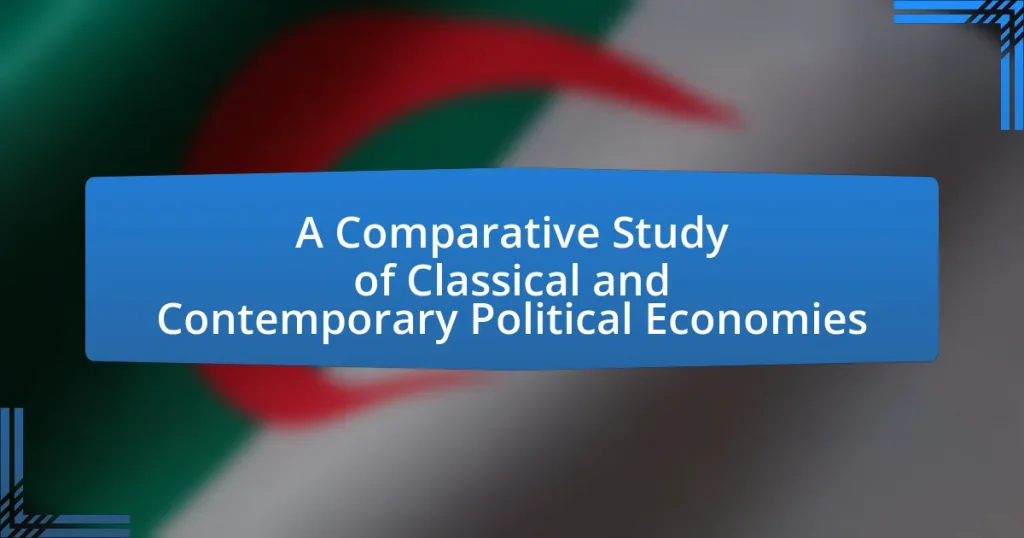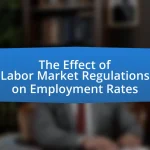The article provides a comparative study of Classical and Contemporary Political Economies, highlighting their foundational theories, methodologies, and implications for policy-making. Classical Political Economy, rooted in the works of economists like Adam Smith and David Ricardo, emphasizes free markets and minimal government intervention, while Contemporary Political Economy incorporates a broader range of social, political, and cultural factors, advocating for regulatory frameworks to address modern economic challenges. Key topics include the evolution of Classical theories, the characteristics of Contemporary approaches, and the practical applications of understanding both schools of thought in shaping effective economic policies. The article also discusses the challenges faced by policymakers in applying these theories and the best practices that can be derived from their comparative analysis.

What are the key differences between Classical and Contemporary Political Economies?
Classical and Contemporary Political Economies differ primarily in their foundational theories and approaches to economic analysis. Classical Political Economy, rooted in the works of economists like Adam Smith and David Ricardo, emphasizes the role of free markets, the labor theory of value, and the importance of production and distribution in economic systems. In contrast, Contemporary Political Economy incorporates a broader range of factors, including social, political, and cultural influences on economic behavior, often utilizing interdisciplinary methods and focusing on issues like globalization and inequality.
For instance, while Classical theorists advocate for minimal government intervention, Contemporary approaches often argue for regulatory frameworks to address market failures and social injustices. This shift reflects a more nuanced understanding of economic dynamics in the modern world, where factors such as technology and international relations play significant roles in shaping economic outcomes.
How did Classical Political Economy emerge and evolve?
Classical Political Economy emerged in the late 18th century, primarily through the works of economists like Adam Smith, David Ricardo, and John Stuart Mill. This school of thought evolved from the need to understand the dynamics of production, distribution, and consumption in a rapidly industrializing society. Adam Smith’s seminal work, “The Wealth of Nations” (1776), laid the foundation by introducing concepts such as the division of labor and the invisible hand, which explained how individual self-interest could lead to economic prosperity.
Subsequently, David Ricardo expanded on these ideas with his theory of comparative advantage, which illustrated how trade could benefit all parties involved, while John Stuart Mill contributed to the understanding of economic growth and social welfare. The evolution of Classical Political Economy continued into the 19th century, as it began to incorporate critiques of capitalism and considerations of social justice, leading to the emergence of various offshoots, including Marxism and Neoclassical economics. This historical progression highlights the foundational role Classical Political Economy played in shaping modern economic thought.
What are the foundational theories of Classical Political Economy?
The foundational theories of Classical Political Economy include the labor theory of value, the theory of distribution, and the principle of free markets. The labor theory of value, primarily articulated by Adam Smith and later expanded by David Ricardo, posits that the value of a good is determined by the amount of labor required to produce it. The theory of distribution explains how income is allocated among the factors of production—land, labor, and capital—emphasizing the role of competition in determining wages and profits. Additionally, the principle of free markets, championed by economists like Smith, asserts that unregulated markets lead to efficient resource allocation and economic growth. These theories laid the groundwork for modern economic thought and continue to influence contemporary economic policies and debates.
Who are the prominent figures in Classical Political Economy?
The prominent figures in Classical Political Economy include Adam Smith, David Ricardo, and John Stuart Mill. Adam Smith, often referred to as the father of economics, introduced key concepts such as the division of labor and the invisible hand in his seminal work “The Wealth of Nations” published in 1776. David Ricardo contributed significantly with his theory of comparative advantage and the labor theory of value, articulated in “Principles of Political Economy and Taxation” in 1817. John Stuart Mill expanded on these ideas, emphasizing the importance of individual liberty and utilitarianism in his writings, particularly in “Principles of Political Economy” published in 1848. These economists laid the foundational principles that shaped the field of economics and influenced subsequent economic thought.
What are the main characteristics of Contemporary Political Economy?
Contemporary Political Economy is characterized by its focus on the interplay between politics and economics, emphasizing the role of institutions, power dynamics, and global interdependencies. This approach integrates various disciplines, including sociology, political science, and economics, to analyze how policies and economic systems affect social outcomes. Additionally, it addresses issues such as inequality, globalization, and environmental sustainability, reflecting the complexities of modern governance and market interactions. The validity of these characteristics is supported by empirical studies that highlight the influence of political decisions on economic performance and social equity, as seen in research by Stiglitz and others, which underscores the importance of institutional frameworks in shaping economic policies.
How do Contemporary Political Economies address modern economic challenges?
Contemporary political economies address modern economic challenges through a combination of regulatory frameworks, social policies, and adaptive economic strategies. These economies emphasize the role of government intervention in mitigating issues such as income inequality, unemployment, and environmental sustainability. For instance, many contemporary political economies implement progressive taxation and social welfare programs to redistribute wealth and support vulnerable populations, which is evidenced by the Nordic model’s success in achieving high levels of social equity and economic stability. Additionally, contemporary approaches often incorporate sustainable development practices, as seen in the European Union’s Green Deal, which aims to address climate change while promoting economic growth. These strategies demonstrate a proactive response to the complexities of today’s global economy, highlighting the importance of adaptability and inclusivity in economic policymaking.
What are the key theories and frameworks in Contemporary Political Economy?
The key theories and frameworks in Contemporary Political Economy include Institutionalism, Marxism, Neoliberalism, and Post-Keynesianism. Institutionalism emphasizes the role of institutions in shaping economic behavior and outcomes, highlighting how political and social contexts influence economic policies. Marxism critiques capitalism, focusing on class struggle and the dynamics of capital accumulation, which remain relevant in analyzing contemporary economic inequalities. Neoliberalism advocates for free markets and minimal government intervention, arguing that deregulation and privatization lead to economic growth, a perspective that has shaped global economic policies since the late 20th century. Post-Keynesianism challenges mainstream economic theories by emphasizing uncertainty and the importance of effective demand, advocating for policies that address unemployment and inequality. These frameworks provide diverse lenses through which to analyze and understand the complexities of modern economies.

How do Classical and Contemporary Political Economies compare in terms of methodology?
Classical and Contemporary Political Economies differ significantly in methodology, with Classical Political Economy primarily relying on deductive reasoning and normative analysis, while Contemporary Political Economy employs a more empirical and interdisciplinary approach. Classical theorists, such as Adam Smith and David Ricardo, utilized deductive methods to derive economic principles from general observations about human behavior and market dynamics. In contrast, Contemporary Political Economy integrates quantitative data analysis, case studies, and insights from various disciplines, including sociology and political science, to understand complex economic phenomena. This shift reflects a broader recognition of the multifaceted nature of economic systems and the influence of political and social factors, as evidenced by the work of scholars like Amartya Sen and Joseph Stiglitz, who emphasize the importance of empirical evidence and real-world applications in their analyses.
What research methods are commonly used in Classical Political Economy?
The research methods commonly used in Classical Political Economy include historical analysis, deductive reasoning, and comparative analysis. Historical analysis allows scholars to examine the development of economic theories and practices over time, as seen in the works of Adam Smith and David Ricardo. Deductive reasoning is employed to derive general principles from specific observations, facilitating the formulation of economic laws. Comparative analysis is utilized to contrast different economic systems and their outcomes, providing insights into the effectiveness of various policies. These methods are foundational in understanding the evolution and implications of economic thought within the context of Classical Political Economy.
How do these methods influence the conclusions drawn in Classical Political Economy?
The methods employed in Classical Political Economy significantly shape the conclusions drawn by emphasizing empirical observation and deductive reasoning. These methods lead to the formulation of theories regarding value, distribution, and economic growth, as seen in the works of economists like Adam Smith and David Ricardo. For instance, Smith’s labor theory of value is derived from systematic observation of labor’s role in production, which influences conclusions about wealth generation and market dynamics. Additionally, Ricardo’s comparative advantage theory, based on deductive reasoning from empirical trade patterns, underscores the benefits of specialization and trade, reinforcing the importance of these methods in deriving economic principles. Thus, the reliance on empirical and deductive methods in Classical Political Economy directly informs the foundational conclusions regarding economic behavior and policy.
What research methods are prevalent in Contemporary Political Economy?
Contemporary Political Economy predominantly employs qualitative and quantitative research methods. Qualitative methods include case studies, interviews, and ethnographic research, which allow for in-depth exploration of political and economic phenomena. Quantitative methods involve statistical analysis, econometric modeling, and surveys, enabling researchers to identify patterns and test hypotheses across larger populations. These methods are supported by the increasing availability of big data and advanced computational techniques, which enhance the robustness of empirical findings in the field.
How do these methods differ from those used in Classical Political Economy?
Contemporary political economy methods differ from those used in Classical Political Economy primarily through their emphasis on empirical analysis and interdisciplinary approaches. While Classical Political Economy focused on abstract theoretical constructs and moral philosophy, contemporary methods incorporate quantitative data, behavioral economics, and insights from sociology and political science. For instance, contemporary analyses often utilize econometric models to assess real-world economic phenomena, contrasting with the Classical focus on deductive reasoning from general principles. This shift reflects a broader understanding of economic systems as complex and influenced by various social factors, as evidenced by the integration of game theory and network analysis in modern economic studies.

What are the implications of Classical and Contemporary Political Economies on policy-making?
Classical and Contemporary Political Economies significantly influence policy-making by shaping the frameworks through which economic and social issues are analyzed and addressed. Classical Political Economy, rooted in the works of Adam Smith and David Ricardo, emphasizes free markets, individual self-interest, and the role of competition, leading to policies that favor deregulation and minimal government intervention. In contrast, Contemporary Political Economy incorporates insights from institutionalism, behavioral economics, and social factors, advocating for policies that address inequality, market failures, and the importance of state intervention in economic affairs. For instance, the Keynesian approach, a contemporary perspective, supports government spending during economic downturns to stimulate demand, which has been validated by historical events such as the Great Depression and the 2008 financial crisis, where active policy responses were crucial for recovery. Thus, the implications of these economic theories on policy-making are profound, as they dictate the strategies governments adopt to manage economies and address societal challenges.
How do Classical Political Economy theories inform economic policy?
Classical Political Economy theories inform economic policy by emphasizing the importance of free markets, competition, and the role of labor in value creation. These theories, articulated by economists such as Adam Smith and David Ricardo, advocate for minimal government intervention, suggesting that markets are self-regulating and that individuals pursuing their self-interest ultimately benefit society. For instance, Smith’s concept of the “invisible hand” illustrates how individual actions can lead to positive economic outcomes without central planning. Additionally, Ricardo’s theory of comparative advantage supports trade policies that enhance economic efficiency and growth. Historical evidence shows that countries adopting these principles, such as the United Kingdom during the Industrial Revolution, experienced significant economic expansion, validating the relevance of Classical Political Economy in shaping effective economic policies.
What historical examples illustrate the impact of Classical theories on policy?
Historical examples illustrating the impact of Classical theories on policy include the implementation of laissez-faire economics in 19th-century Britain, which was influenced by Adam Smith’s principles in “The Wealth of Nations.” This approach led to minimal government intervention in markets, fostering industrial growth and trade expansion. Additionally, the establishment of the Gold Standard in the late 19th century reflected Classical economic theories advocating for stable currency and free trade, which aimed to promote economic stability and growth. These policies were rooted in Classical thought, demonstrating its significant influence on economic practices and governmental policies during that era.
In what ways do Contemporary Political Economy frameworks shape current policies?
Contemporary Political Economy frameworks shape current policies by emphasizing the interconnectedness of economic systems, social structures, and political institutions. These frameworks analyze how global capitalism influences domestic policy decisions, highlighting the role of state intervention in regulating markets and addressing social inequalities. For instance, the rise of neoliberalism has led to policies prioritizing deregulation and privatization, which can be seen in the economic reforms of countries like the United Kingdom and the United States since the 1980s. Additionally, contemporary frameworks incorporate insights from behavioral economics, which inform policies aimed at improving public welfare through nudges and incentives, as evidenced by initiatives like the UK’s Behavioral Insights Team. This integration of diverse perspectives allows policymakers to craft more nuanced and effective responses to complex socio-economic challenges.
What are the challenges faced by policymakers when applying Contemporary theories?
Policymakers face several challenges when applying contemporary theories, primarily due to the complexity and variability of modern socio-economic environments. These challenges include the difficulty in integrating diverse theoretical frameworks, as contemporary theories often encompass a wide range of perspectives that may conflict with one another. Additionally, the rapid pace of technological change complicates the application of these theories, as policymakers must adapt to new information and evolving societal needs.
Moreover, the empirical validation of contemporary theories can be problematic, as many lack robust data or clear methodologies for implementation. For instance, theories like behavioral economics challenge traditional assumptions but require extensive data collection and analysis to inform policy effectively. Lastly, political resistance and public skepticism can hinder the adoption of innovative theories, as stakeholders may prefer established approaches over untested ideas.
What are the practical applications of understanding both Classical and Contemporary Political Economies?
Understanding both Classical and Contemporary Political Economies has practical applications in policy formulation, economic analysis, and social welfare improvement. Policymakers can draw from Classical theories, such as Adam Smith’s concept of the “invisible hand,” to promote free markets while integrating Contemporary insights on market failures and inequality. For instance, the application of Keynesian economics, which emphasizes government intervention during economic downturns, can guide fiscal policies to stabilize economies. Additionally, understanding these economic frameworks enables analysts to assess the impacts of globalization and technological change on labor markets, informing strategies for workforce development. Historical data, such as the Great Depression’s influence on modern economic policies, further illustrates the relevance of these theories in addressing current economic challenges.
How can policymakers leverage insights from both schools of thought?
Policymakers can leverage insights from both classical and contemporary political economies by integrating foundational economic principles with modern analytical frameworks. Classical political economy emphasizes the importance of free markets and individual incentives, which can guide policymakers in promoting economic growth through deregulation and competition. In contrast, contemporary political economy highlights the role of institutions, social factors, and global interdependencies, urging policymakers to consider the impact of governance and social equity in their decisions. By synthesizing these perspectives, policymakers can create balanced strategies that foster economic efficiency while addressing social welfare, as evidenced by successful mixed-economy models in countries like Sweden and Germany, which combine market-driven growth with robust social safety nets.
What best practices can be derived from a comparative study of these economies?
Best practices derived from a comparative study of classical and contemporary political economies include the integration of adaptive policy frameworks, which allow economies to respond effectively to changing global conditions. For instance, classical economies often emphasize the importance of free markets, while contemporary economies incorporate regulatory measures to address market failures. This dual approach can enhance economic resilience and sustainability. Additionally, the study highlights the significance of social safety nets, as seen in contemporary economies, which help mitigate the adverse effects of economic fluctuations on vulnerable populations. Empirical evidence shows that countries with robust social protection systems, such as those in Scandinavia, experience lower poverty rates and greater economic stability. Thus, blending classical market principles with contemporary regulatory and social strategies can lead to more effective economic governance.


